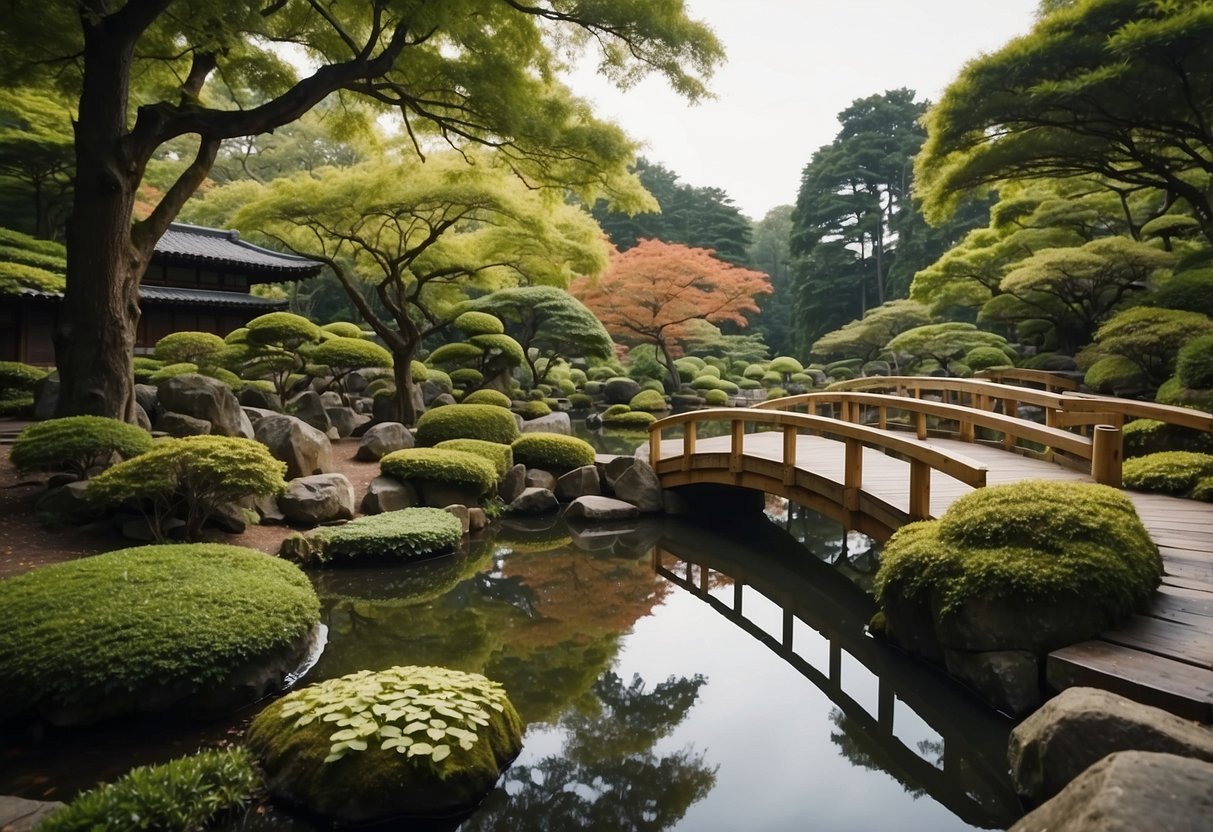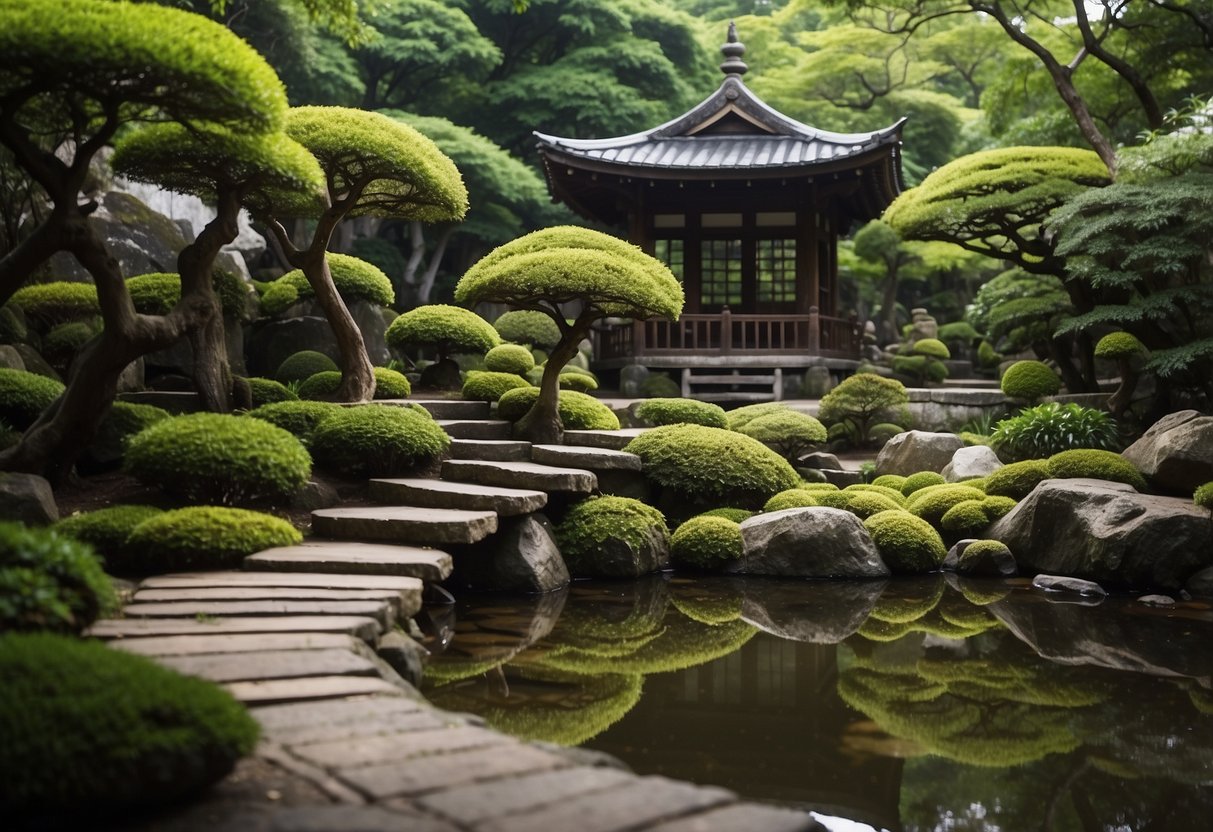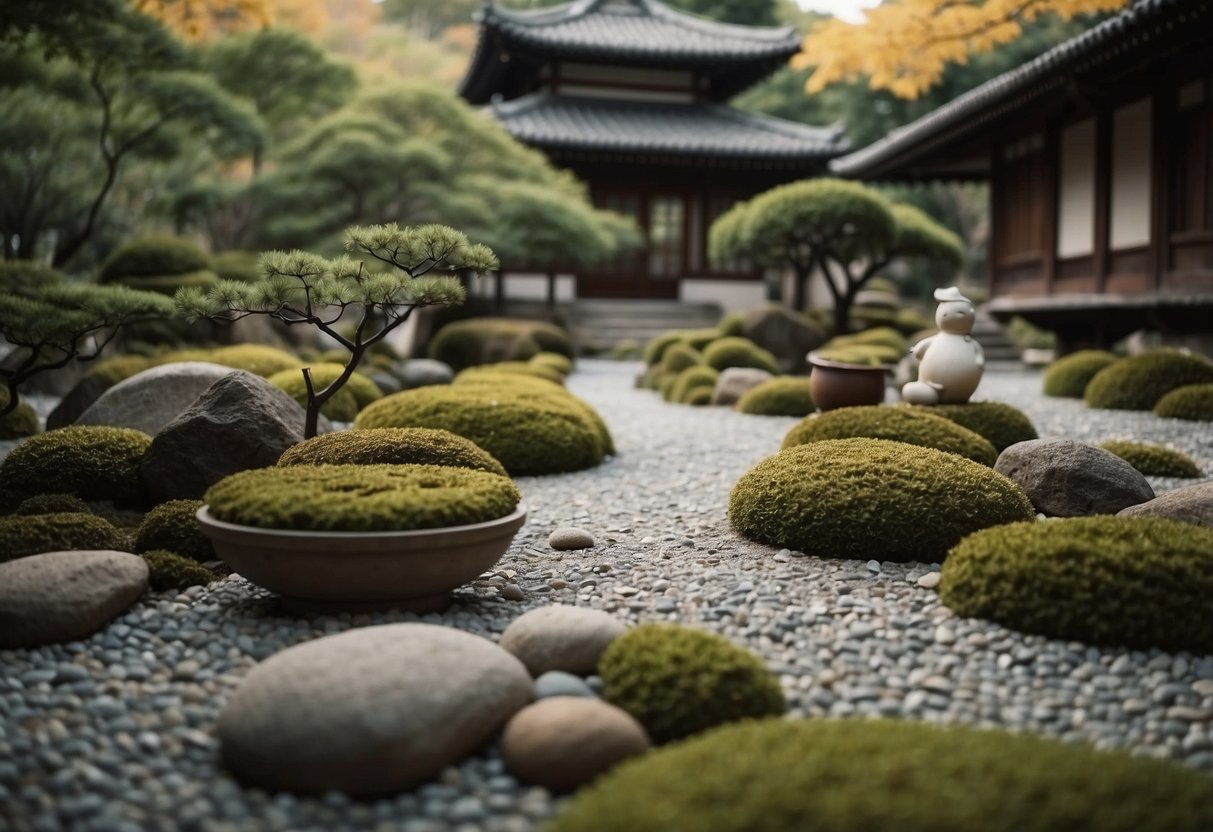Traditional Japanese Garden Design Ideas: Creating a Peaceful Retreat
Creating a traditional Japanese garden in your backyard can be a rewarding way to transform your outdoor space into a peaceful retreat. Japanese gardens are designed to create a sense of harmony and contemplation, blending elements like water, plants, and rocks to evoke tranquility. Whether you have a small courtyard or a spacious yard, you can incorporate these timeless principles to enhance your garden’s beauty.

You don’t need to be an expert landscaper to achieve this elegant look. By understanding the basic elements and aesthetics of Japanese garden design, you can adapt them to suit your own needs. This article will explore various traditional Japanese garden design ideas to help you create your own tranquil oasis.
1) Tsukiyama (Hill Garden)

Tsukiyama, or Hill Garden, is a beautiful and traditional part of Japanese garden design. These gardens feature small, man-made hills that create a scenic landscape.
You can design your Tsukiyama with rocks, gravel, and plants to mimic natural mountains. The placement is important to achieve balance and harmony.
Walking through a Tsukiyama can feel like an adventure, with new views and surprises at every turn. Adding these elements can make your garden feel larger and more dynamic.
Check out examples like the Tsukiyama at Saiho-ji to get inspired!
2) Karesansui (Dry Landscape Garden)

Karesansui, or the dry landscape garden, uses rocks, sand, and gravel to create serene scenes. These gardens, often called Zen gardens, are designed to reflect natural landscapes.
In a Karesansui, rocks symbolize mountains or islands, and sand or gravel represents water. The raked patterns in the sand mimic ripples in a pond or waves in the ocean.
You will find these gardens particularly calming. The careful placement of elements and the minimalistic approach foster a feeling of tranquility and mindfulness. To learn more, visit Art of Dry Landscaping.
3) Chaniwa (Tea Garden)

Chaniwa, also known as tea gardens, are special areas designed for the Japanese tea ceremony. These gardens, like the roji garden, have a simple and rustic feel.
The design of Chaniwa was refined during the Muromachi period. Famous tea masters like Sen no Rikyu played a big role in shaping these gardens. They focused on creating a peaceful and harmonious environment.
Negative space is key in Chaniwa gardens. It creates balance and tranquility, making the garden a perfect setting for the tea ceremony.
4) Pond with Koi Fish

A pond with koi fish can bring tranquility and beauty to your garden. Koi fish are known for their bright colors and graceful swimming.
When designing your koi pond, consider adding water lilies or lotus flowers. These plants provide shade and improve the pond’s ecosystem.
Including a small bridge can make viewing the fish even more enjoyable. A bridge adds a picturesque touch and helps you connect with the serene environment.
5) Stepping Stones

Stepping stones are a key feature in traditional Japanese gardens. They guide you through the space and encourage mindful walking.
These stones can be made from natural materials like stone or wood. Each step creates a sense of exploration and tranquility.
Arranging stepping stones in a curved path helps you to see the garden from different angles. Stepping stones leading to a pond or a stone lantern add to the peaceful atmosphere. For more details, check out Japanese garden paths.
6) Shishi-odoshi (Deer Scarer)

A shishi-odoshi, or “deer scarer,” is a unique feature often found in Japanese gardens. It consists of a hollow bamboo tube that fills with water and then tips over to make a knocking sound.
This gentle noise is designed to scare away critters. The rhythmic movement adds a peaceful, meditative vibe to your garden.
You can learn how to build a shishi-odoshi with simple materials, making it a fun DIY project. Adding one to your garden can enhance both its beauty and serenity.
7) Stone Lanterns

Stone lanterns are a key feature in traditional Japanese gardens. They serve not only as beautiful decor but also hold cultural significance.
You might find Toro lanterns in many gardens, which are often made of stone and used to decorate paths and shrines.
Another type is the Yukimi-Gata, also known as snow-viewing lanterns, which have legs and can be placed near water features. These lanterns add a touch of serenity and light to your garden.
8) Zen Garden with Raked Sand

Creating a Zen garden with raked sand can bring peace and tranquility to your space. Raked sand patterns mimic the flow of water and natural landscapes.
The act of raking requires patience and concentration, making it a form of meditation. This practice helps you focus and relax.
In your Zen garden, the sand represents water and life’s impermanence. The soothing patterns encourage contemplation and calmness. Incorporate decorative rocks, pebbles, and mini trees for added beauty.
9) Tsubo-niwa (Courtyard Garden)

A Tsubo-niwa is a small courtyard garden. It usually measures around 3.3 square meters, which is about the size of two tatami mats. Despite its size, it offers a peaceful retreat.
These gardens often include elements like stepping stones, lanterns, and water features. They can fit into tight spaces, making them perfect for urban settings.
Creating your own Tsubo-niwa can add a serene touch to your home. For more ideas, check out Japanese Courtyard Gardens for inspiration.
10) Ikebana Display

Adding an Ikebana display to your traditional Japanese garden can enhance its beauty and bring a touch of elegance. Ikebana is the art of Japanese flower arranging, known for its simplicity and grace.
Use a shallow vessel with water and a kenzen to hold the flowers in place. Choose a shin branch, a soe branch, and a flower for the hikae element.
Remember, Ikebana is not just about the final look but the process too. Enjoy arranging the elements and take your time to create something beautiful. This mindful practice can add a serene and calming effect to your garden.
History of Traditional Japanese Gardens

Traditional Japanese gardens have transformed over centuries, influenced by cultural exchanges and religious philosophies. Let’s explore how these gardens began and how Zen Buddhism played a crucial role.
Origins and Evolution
The origins of Japanese gardens can be traced back to the Asuka period (538-710 CE). During this era, Japanese garden design began incorporating elements from Chinese gardens. The influence of Chinese landscapes became a blueprint, introducing ponds, islands, and artificial hills to Japanese garden aesthetics.
By the Heian period (794-1185), these gardens became more sophisticated. Aristocrats started to create large, ornate gardens as symbols of power. These gardens were often centered around water features, illustrating a sense of paradise on Earth. Over time, the designs evolved, blending aesthetics from various cultural influences and periods.
Influence of Zen Buddhism
Zen Buddhism significantly shaped Japanese garden design. It was during the Kamakura period (1185-1333) when Zen started influencing Japanese culture profoundly. Zen gardens, or kare-sansui (dry landscape gardens), emphasize simplicity and meditation.
These gardens use rocks, gravel, sand, and moss instead of water to represent natural landscapes. The arrangement of these elements is meant to inspire contemplation and tranquility. Saihō-ji, also known as the Moss Temple in Kyoto, is a prime example of a Zen garden that fosters a peaceful atmosphere through its design.
By integrating Zen principles, Japanese gardens evolved into serene retreats with minimalist designs, becoming spaces for meditation and reflection. The influence of Zen can still be seen in modern Japanese gardens today.
Design Principles of Japanese Gardens

Japanese gardens are designed to create a peaceful, balanced space that incorporates natural elements like water, stones, and plants. This makes them calming and meditative spaces that you can enjoy and reflect in.
Balance and Harmony
Balance and harmony are key in Japanese garden design. This is achieved through the thoughtful arrangement of elements to create visual equilibrium. Negative space, also known as empty space, is important as it allows the eye to rest and appreciate the garden’s beauty. This space creates a sense of calmness and enhances other features. Symmetry is not always necessary; instead, aim for a natural, flowing balance.
Paths in the garden should meander, encouraging you to walk slowly and take in each carefully placed rock or plant. The use of asymmetry and irregularity reflects the natural world, adding authenticity and intrigue.
Use of Elements: Water, Stone, and Plants
Water: Water represents life and purity. It can be in the form of ponds, streams, or waterfalls. These water features add soothing sound and movement, enhancing the tranquility of the space. Even dry gardens use raked gravel to symbolize water.
Stone: Stones are foundational in Japanese gardens. They can signify strength and resilience. Stones are artfully arranged to mimic natural landscapes, like mountains or riverbeds. Whether large boulders or small pebbles, each stone is thoughtfully placed.
Plants: Plants add texture and color to the garden. Use native plants to maintain authenticity. Moss, bamboo, and evergreens are commonly used. Each plant is selected for its seasonal beauty, size, and natural form. This careful selection adds to the garden’s sense of harmony and natural flow.
These elements together create a space that invites reflection and peace, making a Japanese garden a perfect retreat.
Types of Traditional Japanese Gardens

Traditional Japanese gardens come in various styles, each with unique elements and purposes. Here, you will find two prominent types: Karesansui and Tsukiyama.
Karesansui (Dry Landscape Gardens)
Karesansui gardens, also known as zen gardens, are known for their minimalist and contemplative design. These gardens use rocks, gravel, and sand to represent natural landscapes like rivers, mountains, and seas. The gravel is often raked in patterns to mimic the ripples of water. There are usually no plants or water features, focusing instead on simplicity and symbolism.
The design is intended to inspire deep thought and meditation. Rocks are carefully placed to symbolize various elements, such as turtles or cranes, which have cultural significance in Japan.
The dry landscape garden is excellent for small spaces as it doesn’t require much maintenance. It’s ideal if you seek a peaceful, reflective area in your garden.
Tsukiyama (Hill and Pond Gardens)
Tsukiyama gardens recreate natural scenes in miniature form. They combine hills, ponds, and streams to represent entire landscapes. Unlike Karesansui gardens, Tsukiyama gardens include lush greenery, trees, and water features. Evergreen plants like pine and cedar are common, providing a year-round green backdrop.
These gardens often include a variety of flowers, bridges, and stepping stones. Ponds might contain koi fish, adding life and movement. The layout is designed to be viewed from specific vantage points, enhancing the visual experience.
Tsukiyama gardens are typically larger and offer a more immersive experience. They are perfect if you have ample space and enjoy lush, vibrant settings.







